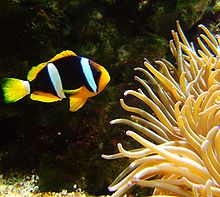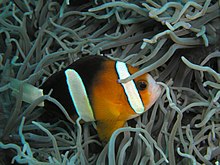Clark's anemonefish
| Clark's anemonefish | |
|---|---|

| |
| Clark's anemonefish with sea anemone | |
Not evaluated (IUCN 3.1)(Global)
| |
| Scientific classification | |
| Kingdom: | Animalia |
| Phylum: | Chordata |
| Class: | Actinopterygii |
| Family: | Pomacentridae |
| Genus: | Amphiprion |
| Species: | A. clarkii
|
| Binomial name | |
| Amphiprion clarkii (J. W. Bennett, 1830)
| |
| Synonyms | |
| |
Amphiprion clarkii, known commonly as Clark's anemonefish and yellowtail clownfish, is a marine fish belonging to the family Pomacentridae, the clownfishes and damselfishes.[2]
Characteristics of anemonefish[]
Clownfish or anemonefish are fishes that, in the wild, form symbiotic mutualisms with sea anemones and are unaffected by the stinging tentacles of the host anemone, see Amphiprioninae § Symbiosis and mutualism. The sea anemone protects the clownfish from predators, as well as providing food through the scraps left from the anemone's meals and occasional dead anemone tentacles. In return, the clownfish defends the anemone from its predators, and parasites.[3] Clownfish are small-sized, 10–18 centimetres (3.9–7.1 in), and depending on species, they are overall yellow, orange, or a reddish or blackish color, and many show white bars or patches. Within species there may be color variations, most commonly according to distribution, but also based on sex, age and host anemone. Clownfish are found in warmer waters of the Indian and Pacific oceans and the Red Sea in sheltered reefs or in shallow lagoons.
In a group of clownfish, there is a strict dominance hierarchy. The largest and most aggressive fish is female and is found at the top. Only two clownfish, a male and a female, in a group reproduce through external fertilization. Clownfish are sequential hermaphrodites, meaning that they develop into males first, and when they mature, they become females. They are not aggressive.
Description[]




Clark's anemonefish is a small-sized fish which grows up to 10 cm as a male and 15 cm as a female.[4][5] It is stocky, laterally compressed, and oval to rounded.
It is colorful, with vivid black, white, and yellow stripes, though the exact pattern shows considerable geographical variation. Usually it is black dorsally and orange-yellow ventrally, the black areas becoming wider with age.[6] There are two vertical white bands, one behind the eye and one above the anus, and the caudal peduncle is white. The snout is orange or pinkish. The dorsal and caudal fins are orange-yellow,[7] and the caudal fin is generally lighter in tone than the rest of the body, sometimes becoming whitish.[8]
Color variations[]
Clark's anemonefish shows the greatest color variations of any anemonefish, with variations based on location, sex, age and host anemone. Adults in Vanuatu and New Caledonia are orange-yellow with two vertical white bands.[9] Sex related color differences may be present, such as the female having a white caudal fin and the male having a yellow caudal fin.[9] Juveniles are orange-yellow with vertical white bands.[7] Fish living with the host anemone Stichodactyla mertensii, Mertens' carpet sea anemone are frequently black except for the snout bars and tail.[9]
Similar species[]
The caudal fin is forked and the base lacks a white bar on Amphiprion latifasciatus. The caudal fin lacks the sharp demarcation between white and dark and the mid-body bar is narrower on Amphiprion allardi and Amphiprion akindynos. The caudal fin is dark on Amphiprion chrysogaster, Amphiprion fuscocaudatus and Amphiprion tricinctus.[9]
Distribution and habitat[]
Clark's anemonefish is the most widely distributed anemonefish, being found in tropical waters from the Indian Ocean to the Western Pacific.[8]
Host anemones[]
Clark's anemonefish is the least host specific anemonefish, living in association with all ten species of sea anemones that host anemonefish:
- Cryptodendrum adhaesivum
- Entacmaea quadricolor Bubble-tip anemone
- Heteractis aurora beaded sea anemone
- Heteractis crispa Sebae anemone
- Heteractis magnifica magnificent sea anemone
- Heteractis malu delicate sea anemone
- Macrodactyla doreensis long tentacle anemone
- Stichodactyla gigantea giant carpet anemone
- Stichodactyla haddoni
- Stichodactyla mertensii Mertens' carpet sea anemone[6][9]
Etymology[]
The specific name and the common name both honour the Scottish engraver John Heaviside Clark (1771–1836) who provided illustrations for Bennett's A Selection from the most remarkable and interesting Fishes found on the Coast of Ceylon, from drawings made in the Southern part of that Island.[10]
References[]
- ^ {{cite iucn |title=Amphiprion clarkii https://www.iucnredlist.org/species/188338/57214118
- ^ "WoRMS - World Register of Marine Species - Amphiprion clarkii (Bennett, 1830)". Marinespecies.org. Retrieved 2014-01-27.
- ^ "Clown Anemonefish". Nat Geo Wild : Animals. National Geographic Society. Retrieved 2011-12-19.
- ^ Lougher, Tristan (2006). What Fish?: A Buyer's Guide to Marine Fish. Interpet Publishing. p. 13. ISBN 0-7641-3256-3.
What size? Males maximum 4 in (10 cm), females maximum 5 7/8 in (15 cm)
- ^ Froese, Rainer and Pauly, Daniel, eds. (2011). "Amphiprion clarkii" in FishBase. January 2011 version.
- ^ a b Padgette' Steer. "ADW: Amphiprion clarkii: INFORMATION". Animaldiversity.ummz.umich.edu. Retrieved 2014-01-27.
- ^ a b "SOUS LES MERS : Amphiprion clarkii - poisson-clown de Clark". Fran.cornu.free.fr. Retrieved 2014-01-27.
- ^ a b "Facts about Clark's Anemonefish (Amphiprion clarkii) - Encyclopedia of Life". Eol.org. 2013-02-14. Retrieved 2014-01-27.
- ^ a b c d e Fautin, Daphne G.; Allen, Gerald R. (1992). Field Guide to Anemone Fishes and Their Host Sea Anemones. Western Australian Museum. p. 66. ISBN 0-7309-5216-9.
- ^ Christopher Scharpf & Kenneth J. Lazara (29 August 2018). "Subseries OVALENTARIA (Incertae sedis): Family POMACENTRIDAE". The ETYFish Project Fish Name Etymology Database. Christopher Scharpf and Kenneth J. Lazara. Retrieved 30 September 2018.
External links[]
 Media related to Amphiprion clarkii at Wikimedia Commons
Media related to Amphiprion clarkii at Wikimedia Commons Data related to Amphiprion clarkii at Wikispecies
Data related to Amphiprion clarkii at Wikispecies- Care information for Amphiprion clarkii at the Aquarium Wiki
- "Amphiprion clarkii". Integrated Taxonomic Information System. Retrieved 30 January 2006.
- Amphiprion clarkii. Bennett, 1830. Retrieved through: World Register of Marine Species.
- Photos of Clark's anemonefish on Sealife Collection
- IUCN Red List endangered species
- Amphiprion
- Fish described in 1830
